Math Final Exam Review Answer
1.2 Graph of Equation
1. Origin-Symmetry, y-axis symmetry, All (x,y and origin)-symmetry
2.(1) x-axis symmetry (2) y-axis symmetry (3) Origin symmetry
3.
4. The center is the midpoint of (-4, -1) and (4, 1),
which is (0,0)
And the radius is the distance b/w (-4, -1) and (0,0) or the distance b/w (4, 1)
and (0,0).
Radius r is So the circle equation is x 2 + y2 =17.
So the circle equation is x 2 + y2 =17.
5. center:(2, 3) and r = 4/3
6. center: (0,-1) and r =
1.3 Linear equations in Two Variables

 Multiplied by 4, the equation is - 2x + y = -4. so y = 2x - 4.
Multiplied by 4, the equation is - 2x + y = -4. so y = 2x - 4.
3. parallel line has same slope as 4x - 3y =7, that is m =
4/3.
So the line equation with m = 4/3 passing through (-3,2) is

4. y = 1
5. The given equation solving for y is y = -6x +10.
So the perpendicular slope is 1/6.
Line equation with m=1/6 passing through (2, 5) is

6. y = 7
7. (1) Two point from the given condition are (8, 0.21)
and (15, 4.75).
m=0.65
y - 0.21 =0.65(t - 8);
y = 0.65t - 4.99
(2) In 2010, t =20. The cash flow per share is $8.01.
8. Two points (0,25000) and (10, 2000) So y = -2300x + 25,000
1.4 Function
1.
(a) Not a function
(b) Not a function
(c) Function
(d) Not a function
(e) Function
(f) Function
2.(1) Not a function (2) Function
3. (1) All real number (-∞,∞)
(2) Radicand ≥ 0; - x ≥ 0; x ≤ 0. So using interval notation (-∞, 0]
(3) Denominator ≠ 0; x2 + x -12 = 0; x = -4, 3; All real number but - 4, 3.
Using interval notation (-∞, - 4)∪(-4, 3)∪(3, ∞)
(4) 9x - 3 ≠ 0, at the same time 9x - 3 ≥ 0. So withouth
equality sign , x > 1/3 .
Using interval notation (1/3 , ∞)
1.5 Analyzing Graphs of Functions
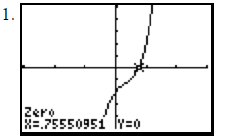
No relative max and min value
There is one zero which is 0.75550951.
2. (1) Domain (-7, -∞) (2) Range [-6, -∞) (3) 4 zeros; x
=1, 5.5, 8.5, 11.5
(4) Increasing (4, 6.5)∪(10,-∞ (5) Decreasing (-2, 4)∪(6.5,
10) (6) Constant (-7,-2)
(7) x - intercepts ; (1, 0), (5.5, 0), (8.5, 0), (11.5, 0) (8) y - intercept (0,
2)
(9) Relative max; 4 @x = 6.5 (10) Relative min; -6@x = 4 and -2@x =10
3. The average rate of change is

1.6 A library of Parent Functions
1.
(1) h(-2.3) = [[ 3(-2.3) – 1 ]] + 2 = [[ -6.9 – 1 ]] + 2 = [[ -7.9 ]] + 2 = -8 +
2 = -6.
(2) h(3.1) = [[ 3(3.1) - 1]] + 2 = [[ 9.3 – 1 ]] + 2 = [[ 8.3 ]] + 2 = 8 + 2 =
10.
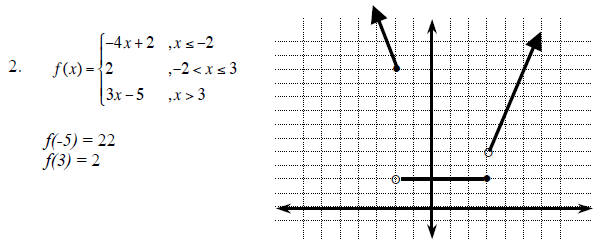
1.7 Transformation of Functions
1.(1) reflection across x-axis, 1 unit to the left and 4 units up
(2) 2 units up
(3) reflection across x-axis, 1 unit to the left and 8 units up
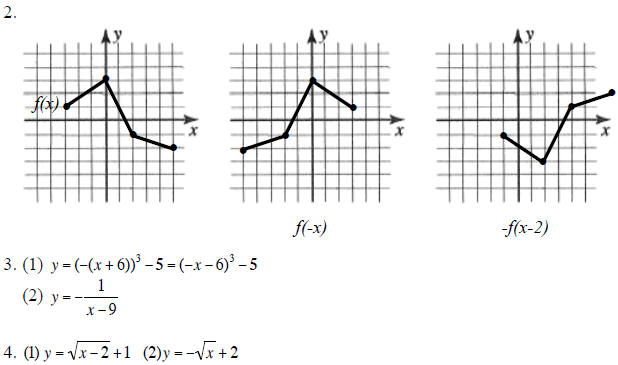
1.8 Composite function
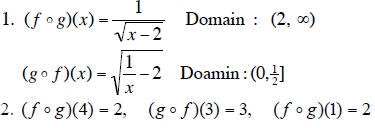

4. X( t ) = 50t (there is a typo in the problem for this
part) and C( x ) = 60x + 750

(2) It's a Cost function depending on hours
1.9 Inverse Function
1.(1) Yes, b/c domain is restricted the graph shows only
half of the function.
(2) No. Horizontal-line Test
2.
3.
 f means f(-2) = 3. So 3 = k(2 - ( -2) - ( -2)3 )
f means f(-2) = 3. So 3 = k(2 - ( -2) - ( -2)3 )
3=12k, k=1/4.
4. You don’t even need to consider what the given function
is.
It’s always true that

5. Switch x- coordinate and y -coordinate and connect the
points. Your inverse graph
should be symmetry to y=x.
2.1 Quadratic function
1.(1) The vertex is (2,4) and it’s parabola open downward
passing through (0,0).
So the equation is y = -(x-2)2+4
(2) Vertex (1,-3), open upward, so y = a(x-1)2 - 3 Since
it’s passing through (0,-2.5),
you can find “a”.
2.(1) ( ½ ,20) (2) x = ½ (3) No x-intercepts (4)(0,21) (5)
all real number (6) [20,∞)
(7) ( ½ , ∞) (8) (-∞ , ½ ) (9) No max (10) 20 @ x = ½
3.(1) 1.5 (2) 104.01 ft (3) 228.64ft
2.2 Polynomial function with its graph
1(1) g(x) (2) h(x) (3) f(x)
2. Right-Hand: as x approaches ∞, y approaches -∞
Left -Hand: as x approaches -∞, y approaches ∞
3. (1) -(x+2)3 (x - 5)(x - 6)
(2) Odd multiplicity: crossing x- axis, starting from right lower corner .
2.3 Polynomial and Synthetic Division

2. 245954
4. Yes. b/c the remainder using synthetic division is 0
5. False -4/7 is a zero.
6. Using synthetic division, remainder should be zero; your remainder should be
c + 210.
So c + 210 = 0, c = -210
2.4 Complex number
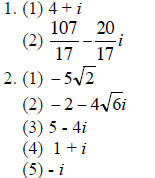
3. False
2.5 Zeros of Polynomial Function

2.6 Rational Functions

2.Domain is different. If you simplify
 then it is same as y = x .But
then it is same as y = x .But
 is not defined at x = 0, 2 but y = x is.
is not defined at x = 0, 2 but y = x is.
The domain of
 is (-∞, 0)U(0, 2)U(2, ∞)
is (-∞, 0)U(0, 2)U(2, ∞)
The domain of y = x is (-∞, ∞)
3.(1) g(x) = x + 5/x; VA: x = 0. Slant asymptote : y
= x
(2)
 VA x=2 Slant asym: y = 2x- 1
VA x=2 Slant asym: y = 2x- 1
The graphs are placed between two asymptotes. Check with your calculator
4.(1) substitute t =6 and 30 to get the corresponding N
values’
(2) If you graph it, VA is x = -25 or t = -25 and HA is y = 1500 or N = 1500. So
as
time increase, which means as t approaches ∞, N is approaching 1500. (Since it
is
asymptote graph is not toughing or passing through).
So the limiting size is 1500.
1. Critical number is either undefined points or zeros. x = 0, 5
2. Put two functions into the calculator. One is
 and
the other is y = 2.
and
the other is y = 2.
Since we are looking for the intervals for
y ≤ 2, using intersection function key and
recognizing that VA’s are at x = -4 and x = 5, we will get the following
interval as a
solution set .
(-∞, -8.7]U(-4, 2.7]U(5, ∞)
| Prev | Next |